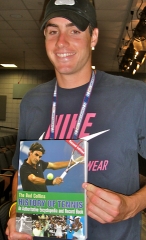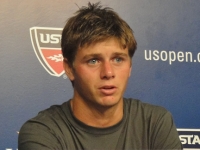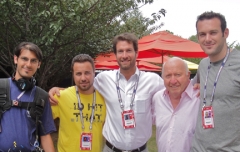
NEW YORK – Waiting for Earl…
Thousands decided to wait for Earl the Hurricane at the tennis parlor in Flushing Meadows. They packed umbrellas, raincoats, hip boots, transistors, emergency rations, perhaps collapsible row boats and kerosene lanterns.
Peering at the rumpled gray sky and the US Open’s blue tennis courts, the tennis nuts were ready for anything. They weren’t frightened away by the weather bulletins, or the flash-backs to Katrina.
“We’ll resist by showing up,” said a fan from India. “I didn’t come all this way to miss the US Open. If I drown here, it’s not the worst way to go.”
After all, the tennis degenerates have proudly been through a few hurricanes.
What about 1938? At a time before hurricanes were baptized, and nobody knew they were coming, a no-name monster devastated the northeast, and washed out the US Championships up the road at Forest Hills. Californian Don Budge was about to complete the first ever Grand Slam, having won the Australian, French and Wimbledon, but no-name stopped him in the semifinals.
“We had to wait almost a week for the courts to be playable,” Budge recalled. “I was up against my pal and roommate, Gene Mako, whom I beat in the final. After the storm subsided we went dancing every night, making sure neither of us had the edge in sleep.”
In 1955 Hurricane Diane roared through New England, flooding Boston’s Longwood Cricket Club where the US Doubles was underway – soon under water for a week. Ballboys swam and boated on the courts to please photographers.
In those days this biggie now called the US Open was split into two championships: Doubles at Longwood, Singles at Forest Hills.
After a week the Longwood lawns surfaced and dried out. But by then all the marquee men (such as Ken Rosewall, Tony Trabert, Lew Hoad, Vic Seixas) had deserted, feeling the tourney would never end. That left it to unknown Japanese Kosei Kamo and Atsushi Miyagi to triumph over a couple of American college boys, Jerry Moss and Bill Quillian.
But a great team did hang around on room-and-board amateur-days subsidies to win the other title: Margaret Osborne duPont and Louise Brough on their way to the Hall of Fame.

A lesser blowhard, Hurricane Donna delayed the 1960 Singles finals for a couple of days.
So, waiting for Earl, we got through Friday with one brief interruption for anemic sprinkles. If the Grandstand Court had rafters, hundreds would have been hanging from them to get a glimpse of the latest American Great Bright Hope – Ryan Harrison of Shreveport, Louisiana. The court overflowed with 6,106 ranting viewers, while untold numbers more watched from balconies and facing a huge TV in the plaza.
Eighteen-year-old-year-old Ryan overflowed with confidence – except when it vanished as he held three match points in the excruciating fifth set tie-breaker. Fresh from winning New Haven, the skinny 6-4 Ukrainian Sergiy Stakhovsky arose from 3-6 in the breaker to carry the day in 4 hours, 6-3, 5-7, 3-6, 6-3, 7-6 (8-6).
At 6-5, the third match point, with serve, Harrison missed a backhand, double faulted and watched his foe’s leaping volley end it.
The kid can play. Don’t doubt that. But this home-schooled teen-ager, ranked No. 220, needs more education from older more experienced hands like No. 36 Stakhovsky.
Ryan was upbeat, relishing the crowd’s vocal salutes, glad to have been part of it and eager for more. “I’ve never had it like that, definitely not. I mean, that was incredible. You know, they [spectators] were great. There were some balls that I ran down and was able to scoop up and get back in the point, win some points, just because of the energy and the electricity that I’m feeling ….. I mean, I can’t remember the last time I was, you know, late in a match like that, jogging off every changeover. I mean I just felt good. The body felt good. I felt energetic, The crowd played an incredible part in that, and I’m really thankful for their support and really happy that I was able to play here.”
Waiting for Earl was worth it, if only for that match. But for the jingoists there were also Long John Isner with 24 aces as he got past Swiss Marco Chiudinelli, 6-3, 3-6, 7-6 (9-7), 6-4, and Sam Querrey over Marcel Granollers, 6-2, 6-3, 6-4. Chiudinelli is known at home, Basel, as a schoolmate of Roger Federer, which may or may not earn him a Swiss watch.
Isner cannot avoid questions about Wimbledon’s “The Endless Match,” but good naturedly says about the intense interest in his record setting match [70-68 final set!]: “It’s been great. That’s going to stick with me for really as long as I live. I embrace it (the interest). I think it’s really cool what Nicolas and I did that day.”

Unlike Mahut, who probably returned to action too soon by playing Newport the week after Wimbledon and injured his back, Isner’s physical condition is fine: “I know that for me, you know, I don’t feel like I’m feeling the lasting effects of that match particularly. I’m tired here but it’s because of my recent ankle injury.”
Still waiting for Earl?
Somebody asks me if there were any tennis players named Earl? Well, Earl (Butch) Buchholz went into the Hall of Fame five years ago. And a former US top ten player, Earl Cochell, was banned for life, a penalty for cursing the referee at the 1951 Singles Championship.
Life? The US Tennis Association could get away with such possessive treatment of players in the amateur era, as did other national federations.
But I’m through waiting for this Earl. It was a flop.
Leave a Reply